CHCECE005 Assessment 2: Childcare and Toddler Development
VerifiedAdded on 2023/06/10
|5
|1176
|98
Homework Assignment
AI Summary
This document presents a detailed response to CHCECE005 Assessment 2, focusing on strategies for nurturing and stimulating the development of children aged 6 months and 18 months. The solution addresses various aspects, including interaction, communication, and creating stimulating environments. It explores effective methods for caregivers to support children's emotional well-being, cognitive learning, and physical development through play and daily routines. The assignment also emphasizes the importance of responding to children's cues, encouraging movement, and providing opportunities for exploration. References to relevant research and publications are included to support the strategies discussed, offering a comprehensive guide for childcare professionals and students studying early childhood education.
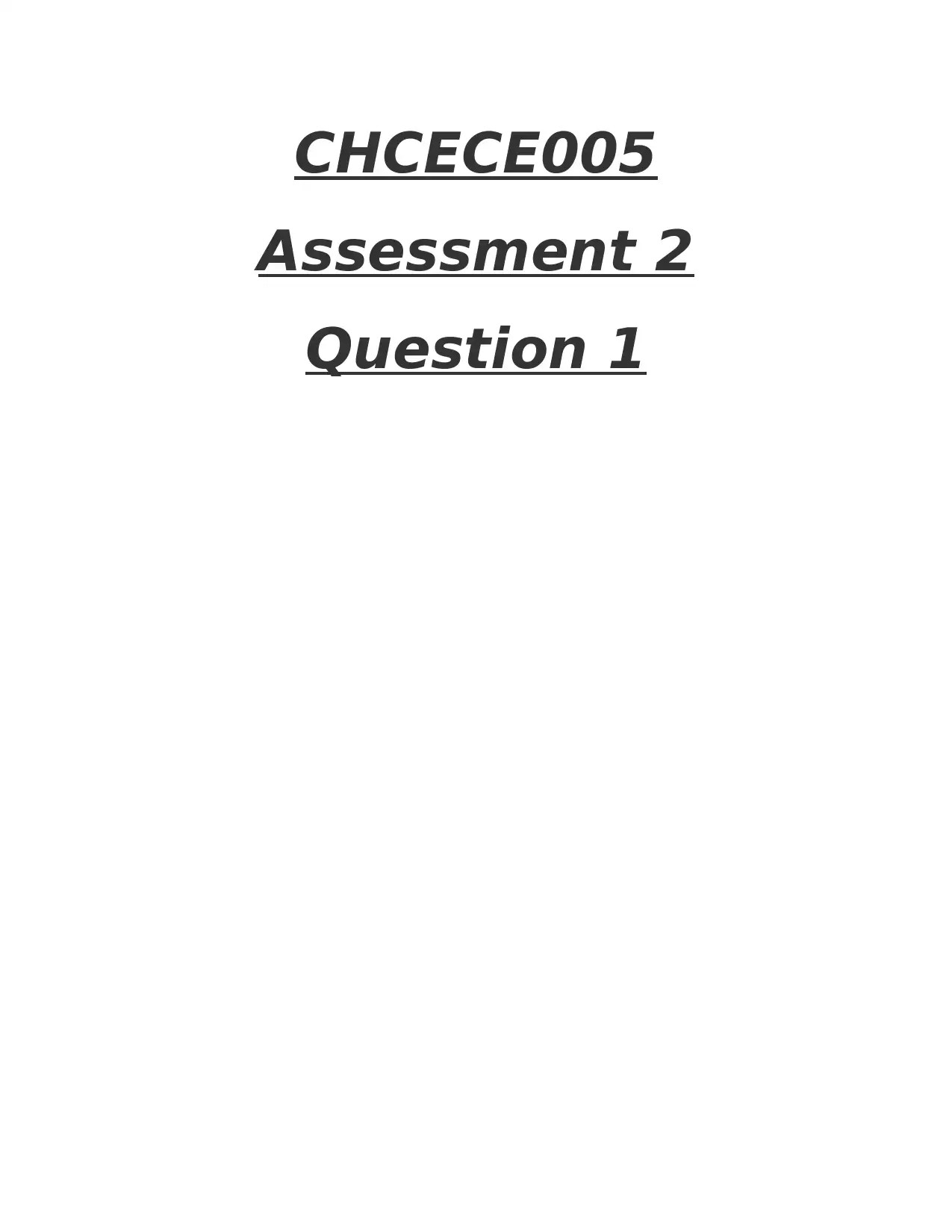
CHCECE005
Assessment 2
Question 1
Assessment 2
Question 1
Paraphrase This Document
Need a fresh take? Get an instant paraphrase of this document with our AI Paraphraser
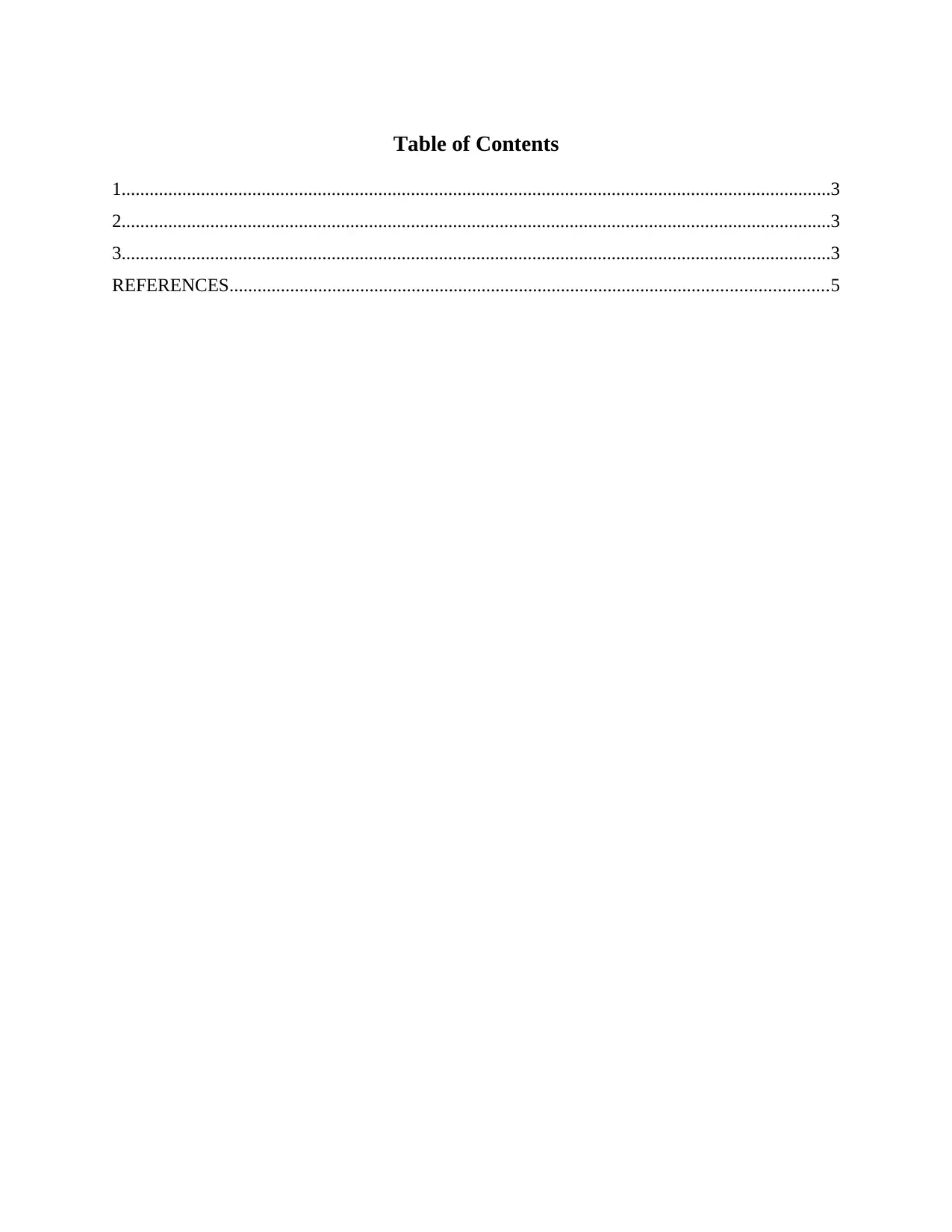
Table of Contents
1........................................................................................................................................................3
2........................................................................................................................................................3
3........................................................................................................................................................3
REFERENCES................................................................................................................................5
1........................................................................................................................................................3
2........................................................................................................................................................3
3........................................................................................................................................................3
REFERENCES................................................................................................................................5
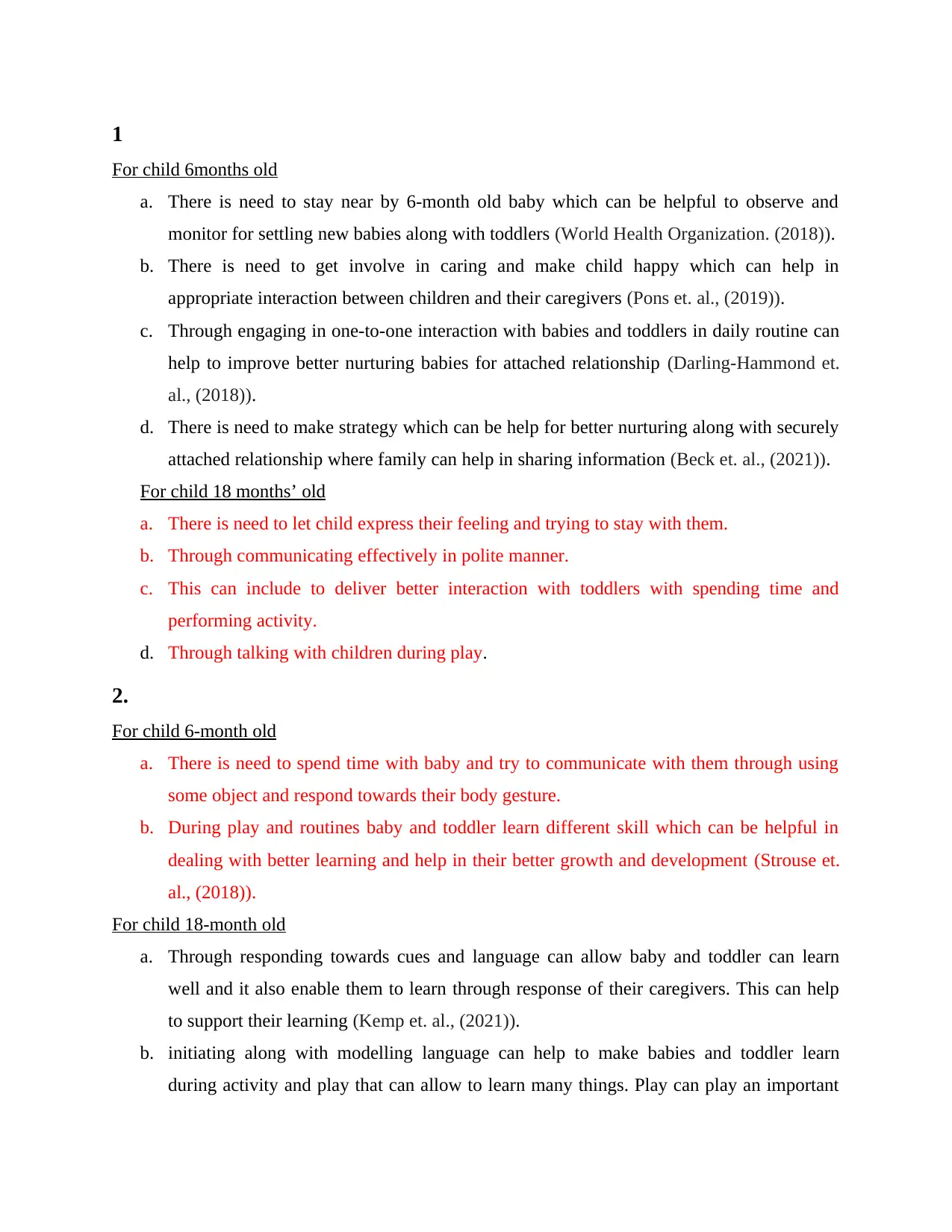
1
For child 6months old
a. There is need to stay near by 6-month old baby which can be helpful to observe and
monitor for settling new babies along with toddlers (World Health Organization. (2018)).
b. There is need to get involve in caring and make child happy which can help in
appropriate interaction between children and their caregivers (Pons et. al., (2019)).
c. Through engaging in one-to-one interaction with babies and toddlers in daily routine can
help to improve better nurturing babies for attached relationship (Darling-Hammond et.
al., (2018)).
d. There is need to make strategy which can be help for better nurturing along with securely
attached relationship where family can help in sharing information (Beck et. al., (2021)).
For child 18 months’ old
a. There is need to let child express their feeling and trying to stay with them.
b. Through communicating effectively in polite manner.
c. This can include to deliver better interaction with toddlers with spending time and
performing activity.
d. Through talking with children during play.
2.
For child 6-month old
a. There is need to spend time with baby and try to communicate with them through using
some object and respond towards their body gesture.
b. During play and routines baby and toddler learn different skill which can be helpful in
dealing with better learning and help in their better growth and development (Strouse et.
al., (2018)).
For child 18-month old
a. Through responding towards cues and language can allow baby and toddler can learn
well and it also enable them to learn through response of their caregivers. This can help
to support their learning (Kemp et. al., (2021)).
b. initiating along with modelling language can help to make babies and toddler learn
during activity and play that can allow to learn many things. Play can play an important
For child 6months old
a. There is need to stay near by 6-month old baby which can be helpful to observe and
monitor for settling new babies along with toddlers (World Health Organization. (2018)).
b. There is need to get involve in caring and make child happy which can help in
appropriate interaction between children and their caregivers (Pons et. al., (2019)).
c. Through engaging in one-to-one interaction with babies and toddlers in daily routine can
help to improve better nurturing babies for attached relationship (Darling-Hammond et.
al., (2018)).
d. There is need to make strategy which can be help for better nurturing along with securely
attached relationship where family can help in sharing information (Beck et. al., (2021)).
For child 18 months’ old
a. There is need to let child express their feeling and trying to stay with them.
b. Through communicating effectively in polite manner.
c. This can include to deliver better interaction with toddlers with spending time and
performing activity.
d. Through talking with children during play.
2.
For child 6-month old
a. There is need to spend time with baby and try to communicate with them through using
some object and respond towards their body gesture.
b. During play and routines baby and toddler learn different skill which can be helpful in
dealing with better learning and help in their better growth and development (Strouse et.
al., (2018)).
For child 18-month old
a. Through responding towards cues and language can allow baby and toddler can learn
well and it also enable them to learn through response of their caregivers. This can help
to support their learning (Kemp et. al., (2021)).
b. initiating along with modelling language can help to make babies and toddler learn
during activity and play that can allow to learn many things. Play can play an important
⊘ This is a preview!⊘
Do you want full access?
Subscribe today to unlock all pages.

Trusted by 1+ million students worldwide
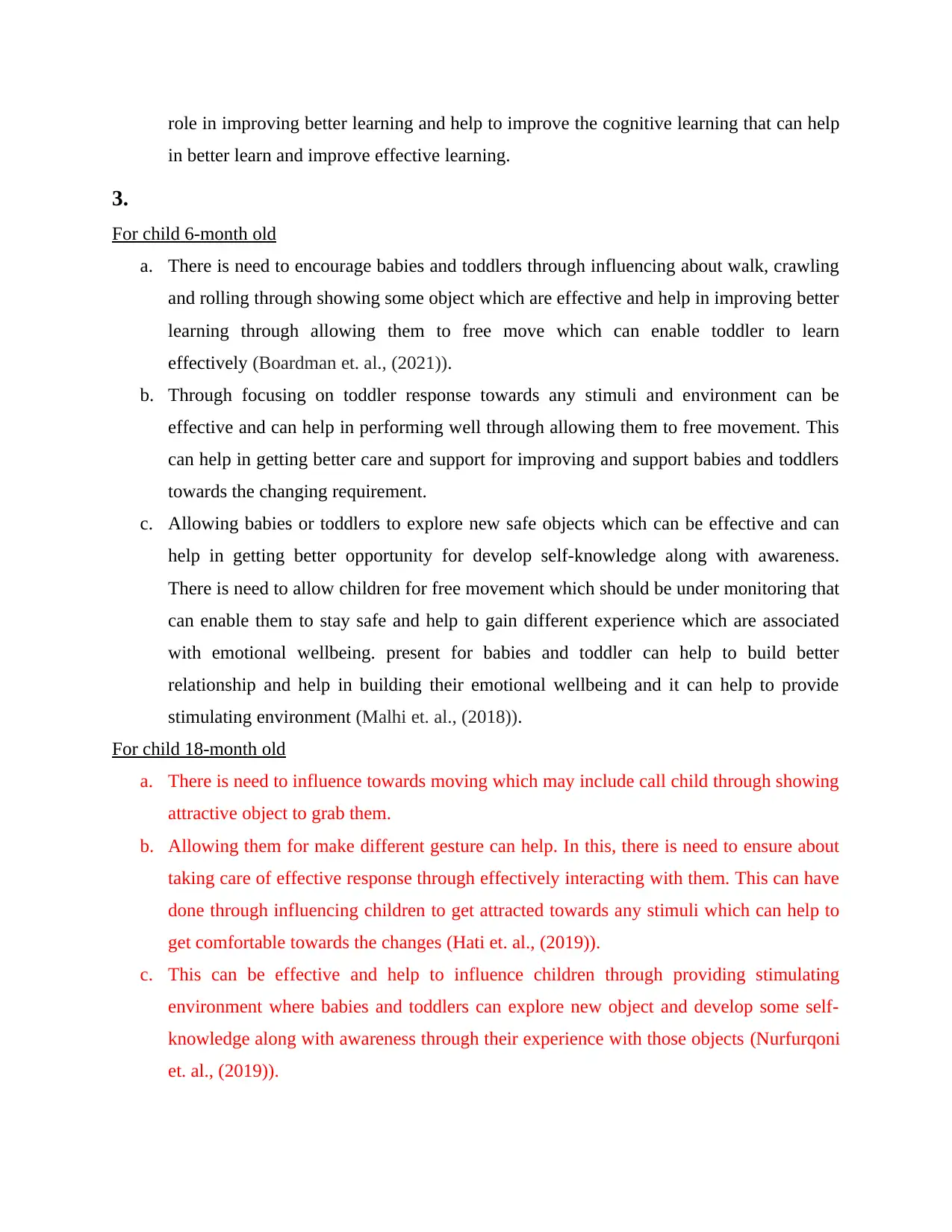
role in improving better learning and help to improve the cognitive learning that can help
in better learn and improve effective learning.
3.
For child 6-month old
a. There is need to encourage babies and toddlers through influencing about walk, crawling
and rolling through showing some object which are effective and help in improving better
learning through allowing them to free move which can enable toddler to learn
effectively (Boardman et. al., (2021)).
b. Through focusing on toddler response towards any stimuli and environment can be
effective and can help in performing well through allowing them to free movement. This
can help in getting better care and support for improving and support babies and toddlers
towards the changing requirement.
c. Allowing babies or toddlers to explore new safe objects which can be effective and can
help in getting better opportunity for develop self-knowledge along with awareness.
There is need to allow children for free movement which should be under monitoring that
can enable them to stay safe and help to gain different experience which are associated
with emotional wellbeing. present for babies and toddler can help to build better
relationship and help in building their emotional wellbeing and it can help to provide
stimulating environment (Malhi et. al., (2018)).
For child 18-month old
a. There is need to influence towards moving which may include call child through showing
attractive object to grab them.
b. Allowing them for make different gesture can help. In this, there is need to ensure about
taking care of effective response through effectively interacting with them. This can have
done through influencing children to get attracted towards any stimuli which can help to
get comfortable towards the changes (Hati et. al., (2019)).
c. This can be effective and help to influence children through providing stimulating
environment where babies and toddlers can explore new object and develop some self-
knowledge along with awareness through their experience with those objects (Nurfurqoni
et. al., (2019)).
in better learn and improve effective learning.
3.
For child 6-month old
a. There is need to encourage babies and toddlers through influencing about walk, crawling
and rolling through showing some object which are effective and help in improving better
learning through allowing them to free move which can enable toddler to learn
effectively (Boardman et. al., (2021)).
b. Through focusing on toddler response towards any stimuli and environment can be
effective and can help in performing well through allowing them to free movement. This
can help in getting better care and support for improving and support babies and toddlers
towards the changing requirement.
c. Allowing babies or toddlers to explore new safe objects which can be effective and can
help in getting better opportunity for develop self-knowledge along with awareness.
There is need to allow children for free movement which should be under monitoring that
can enable them to stay safe and help to gain different experience which are associated
with emotional wellbeing. present for babies and toddler can help to build better
relationship and help in building their emotional wellbeing and it can help to provide
stimulating environment (Malhi et. al., (2018)).
For child 18-month old
a. There is need to influence towards moving which may include call child through showing
attractive object to grab them.
b. Allowing them for make different gesture can help. In this, there is need to ensure about
taking care of effective response through effectively interacting with them. This can have
done through influencing children to get attracted towards any stimuli which can help to
get comfortable towards the changes (Hati et. al., (2019)).
c. This can be effective and help to influence children through providing stimulating
environment where babies and toddlers can explore new object and develop some self-
knowledge along with awareness through their experience with those objects (Nurfurqoni
et. al., (2019)).
Paraphrase This Document
Need a fresh take? Get an instant paraphrase of this document with our AI Paraphraser
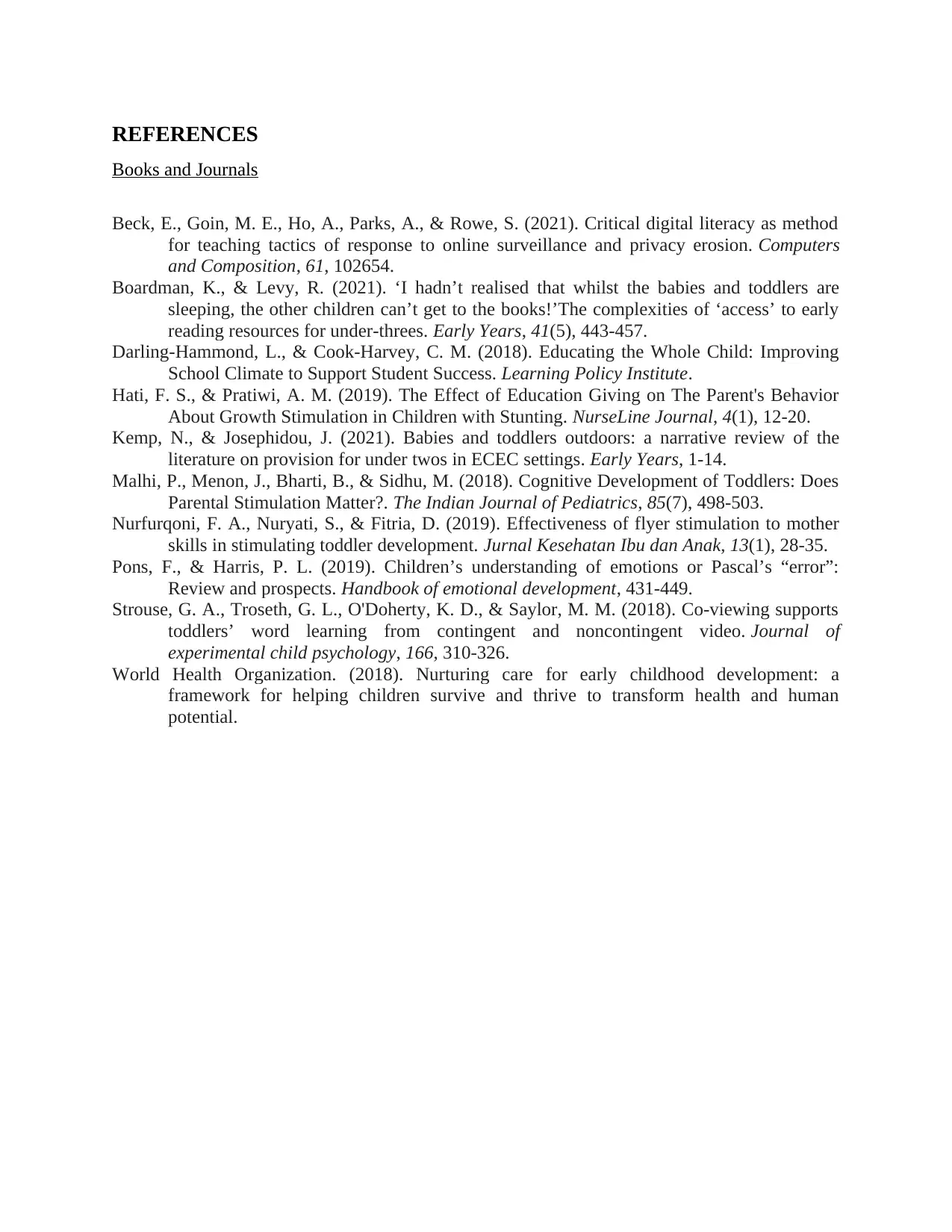
REFERENCES
Books and Journals
Beck, E., Goin, M. E., Ho, A., Parks, A., & Rowe, S. (2021). Critical digital literacy as method
for teaching tactics of response to online surveillance and privacy erosion. Computers
and Composition, 61, 102654.
Boardman, K., & Levy, R. (2021). ‘I hadn’t realised that whilst the babies and toddlers are
sleeping, the other children can’t get to the books!’The complexities of ‘access’ to early
reading resources for under-threes. Early Years, 41(5), 443-457.
Darling-Hammond, L., & Cook-Harvey, C. M. (2018). Educating the Whole Child: Improving
School Climate to Support Student Success. Learning Policy Institute.
Hati, F. S., & Pratiwi, A. M. (2019). The Effect of Education Giving on The Parent's Behavior
About Growth Stimulation in Children with Stunting. NurseLine Journal, 4(1), 12-20.
Kemp, N., & Josephidou, J. (2021). Babies and toddlers outdoors: a narrative review of the
literature on provision for under twos in ECEC settings. Early Years, 1-14.
Malhi, P., Menon, J., Bharti, B., & Sidhu, M. (2018). Cognitive Development of Toddlers: Does
Parental Stimulation Matter?. The Indian Journal of Pediatrics, 85(7), 498-503.
Nurfurqoni, F. A., Nuryati, S., & Fitria, D. (2019). Effectiveness of flyer stimulation to mother
skills in stimulating toddler development. Jurnal Kesehatan Ibu dan Anak, 13(1), 28-35.
Pons, F., & Harris, P. L. (2019). Children’s understanding of emotions or Pascal’s “error”:
Review and prospects. Handbook of emotional development, 431-449.
Strouse, G. A., Troseth, G. L., O'Doherty, K. D., & Saylor, M. M. (2018). Co-viewing supports
toddlers’ word learning from contingent and noncontingent video. Journal of
experimental child psychology, 166, 310-326.
World Health Organization. (2018). Nurturing care for early childhood development: a
framework for helping children survive and thrive to transform health and human
potential.
Books and Journals
Beck, E., Goin, M. E., Ho, A., Parks, A., & Rowe, S. (2021). Critical digital literacy as method
for teaching tactics of response to online surveillance and privacy erosion. Computers
and Composition, 61, 102654.
Boardman, K., & Levy, R. (2021). ‘I hadn’t realised that whilst the babies and toddlers are
sleeping, the other children can’t get to the books!’The complexities of ‘access’ to early
reading resources for under-threes. Early Years, 41(5), 443-457.
Darling-Hammond, L., & Cook-Harvey, C. M. (2018). Educating the Whole Child: Improving
School Climate to Support Student Success. Learning Policy Institute.
Hati, F. S., & Pratiwi, A. M. (2019). The Effect of Education Giving on The Parent's Behavior
About Growth Stimulation in Children with Stunting. NurseLine Journal, 4(1), 12-20.
Kemp, N., & Josephidou, J. (2021). Babies and toddlers outdoors: a narrative review of the
literature on provision for under twos in ECEC settings. Early Years, 1-14.
Malhi, P., Menon, J., Bharti, B., & Sidhu, M. (2018). Cognitive Development of Toddlers: Does
Parental Stimulation Matter?. The Indian Journal of Pediatrics, 85(7), 498-503.
Nurfurqoni, F. A., Nuryati, S., & Fitria, D. (2019). Effectiveness of flyer stimulation to mother
skills in stimulating toddler development. Jurnal Kesehatan Ibu dan Anak, 13(1), 28-35.
Pons, F., & Harris, P. L. (2019). Children’s understanding of emotions or Pascal’s “error”:
Review and prospects. Handbook of emotional development, 431-449.
Strouse, G. A., Troseth, G. L., O'Doherty, K. D., & Saylor, M. M. (2018). Co-viewing supports
toddlers’ word learning from contingent and noncontingent video. Journal of
experimental child psychology, 166, 310-326.
World Health Organization. (2018). Nurturing care for early childhood development: a
framework for helping children survive and thrive to transform health and human
potential.
1 out of 5
Related Documents
Your All-in-One AI-Powered Toolkit for Academic Success.
+13062052269
info@desklib.com
Available 24*7 on WhatsApp / Email
![[object Object]](/_next/static/media/star-bottom.7253800d.svg)
Unlock your academic potential
Copyright © 2020–2025 A2Z Services. All Rights Reserved. Developed and managed by ZUCOL.




